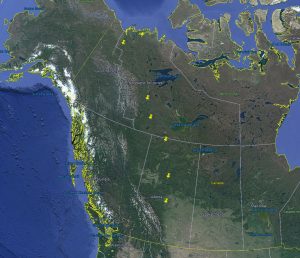Fire and Ice: Impacts of wildfire and permafrost thaw
Our research aims to identify and quantify impacts of disturbances in peatland-rich northern catchments on the Taiga Plains of western Canada, particularly focusing on the individual and interactive effects of wildfire and permafrost thaw. The research will be carried out at a number of peatland sites that represent sequences with regards to their time since permafrost thaw or fire. By studying changes along these sequences, we will be able to learn about long term effects. In particular, we will study A) how permafrost thaw affects greenhouse gas emissions and carbon storage in peatlands over decades to centuries; B) how fire affects permafrost stability and soil respiration of peatlands over years and decades following fire; C) how fire and permafrost thaw alters stream export of dissolved organic matter that originate from peatlands, including contaminants, and; D) how altered chemical compositions of dissolved organic matter due to disturbances alter how it is degraded as it moves downstream. The research is funded by NSERC Discovery, Polar Knowledge Canada, and is coordinated with the Taiga Plains Research Network.

Terrestrial – Aquatic linkages
This research is aimed at understanding how hydrogeological landscape settings and climate interact to influence linkages between terrestrial and aquatic ecosystems. This understanding is essential for projecting impacts of both climate change and human land use activities for both water quality aspects and landscape carbon cycling. Much of the research is carried out within the Utikuma Research Study Area (URSA).

Permafrost Carbon Network
The Permafrost Carbon Network is part of the multi-million dollar Study of Environmental Arctic Change (SEARCH) project. The SEARCH project, headed by the University of Alaska Fairbanks and Northern Arizona University, is a system-scale, cross-disciplinary research program that seeks to connect the science of Arctic change to decision makers. The network has been successfully running for the last five years and includes more than 300 scientist from 88 research institutions located in 17 countries. As members of the Permafrost Carbon Network, members of the CAWS research group are contributing towards several synthesis projects with focus on Arctic methane emissions, thermokarst mapping, and old carbon contribution to soil respiration.

Field Research Sites
Current research is carried out in central and northern Alberta, and in the Northwest Territories, with intensive study sites indicated on the map.
